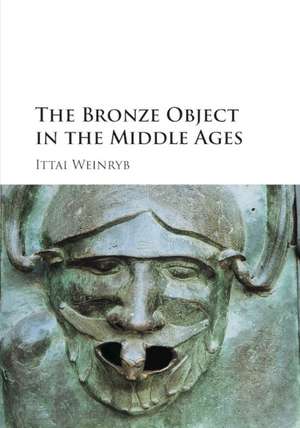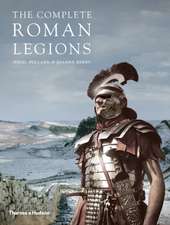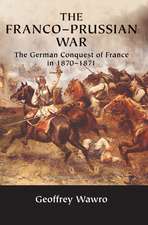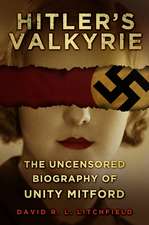The Bronze Object in the Middle Ages
Autor Ittai Weinryben Limba Engleză Paperback – 4 noi 2020
| Toate formatele și edițiile | Preț | Express |
|---|---|---|
| Paperback (1) | 367.56 lei 6-8 săpt. | |
| Cambridge University Press – 4 noi 2020 | 367.56 lei 6-8 săpt. | |
| Hardback (1) | 706.72 lei 6-8 săpt. | |
| Cambridge University Press – 17 apr 2016 | 706.72 lei 6-8 săpt. |
Preț: 367.56 lei
Nou
Puncte Express: 551
Preț estimativ în valută:
70.34€ • 72.67$ • 58.54£
70.34€ • 72.67$ • 58.54£
Carte tipărită la comandă
Livrare economică 26 martie-09 aprilie
Preluare comenzi: 021 569.72.76
Specificații
ISBN-13: 9781107559103
ISBN-10: 1107559103
Pagini: 318
Ilustrații: 12 b/w illus. 108 colour illus.
Dimensiuni: 176 x 254 x 16 mm
Greutate: 0.56 kg
Editura: Cambridge University Press
Colecția Cambridge University Press
Locul publicării:New York, United States
ISBN-10: 1107559103
Pagini: 318
Ilustrații: 12 b/w illus. 108 colour illus.
Dimensiuni: 176 x 254 x 16 mm
Greutate: 0.56 kg
Editura: Cambridge University Press
Colecția Cambridge University Press
Locul publicării:New York, United States
Cuprins
Introduction: of bronze things; 1. Making; 2. Signification; 3. Acting; 4. Being; Appendix 1. Adhémar of Chabannes (988–1034); Appendix 2. Hugh of Fouilloy (c.1096–c.1172); Appendix 3. On the Benediction of Bells, excerpt from the Gellone Sacramentary.
Recenzii
'Ittai Weinryb's The Bronze Object in the Middle Ages gives us a study that comes close to being the gleeful opposite of a whistlestop tour of the masterpieces of medieval sculpture in bronze, for all that it examines a number of them en passant, and in a way it is only the choice of the word 'object' that ever so slightly gives the game away. For while statues may just about qualify as objects, things such as doors, fonts, fountains, reliquaries, bells and even mechanical clocks and other automata more truly fit the bill, and they soon emerge as the main heroes here.' David Ekserdjian, The Arts Newspaper
'Ittai Weinryb's The Bronze Object in the Middle Ages thus signals a welcome, provocative, occasionally challenging, and decidedly fruitful addition to the field. A corpus-specific survey it is not. Instead, Weinryb offers a sustained and many-faceted meditation on how bronze objects, broadly defined, were conceived, perceived, and experienced; how they interacted with their environments and their communities; how they embodied marvelous technologies and different practices of knowledge - in short, how the bronze object was significant.' Joseph Salvatore Ackley, CAA Reviews
'… [A]mbitious in scope and philosophical and imaginative in its realization. … both provocative and stimulating of further study along unexpected avenues of thought.' Cathy Oakes, History
'Ittai Weinryb has written an absorbing and stimulating book about the multivalent meanings of bronze in the Middle Ages and how those meanings are expressed in items created through the lost-wax bronze casting technique. … the book's ambition, the originality of its approach, the richness of its arguments, and the verve with which it is written will undoubtedly ensure its lasting significance for anyone interested in medieval objects, bronze or otherwise.' Douglas Brine, The Medieval Review
'It is rarely said of an art historical study that it not only contributes interesting details to a specialized topic but also has the potential to change our awareness and understanding of the field.' Gerhard Lutz, Speculum
'This is a thought-provoking and ambitious study of monumental cast bronze objects produced through the lost wax process during the Middle Ages. Ittai Weinryb examines a wide range of objects and textual sources, and seeks to move beyond the questions of style and Romanitas that have traditionally dominated literature about medieval bronzes. … The study encompasses doors, bells, fountains and figurative sculpture, concentrating mainly on the modern regions of Germany and Italy. The writing is engaging, and the arguments are supported by excellent illustrations.' L. Cleaver, The English Historical Review
'Ittai Weinryb's The Bronze Object in the Middle Ages thus signals a welcome, provocative, occasionally challenging, and decidedly fruitful addition to the field. A corpus-specific survey it is not. Instead, Weinryb offers a sustained and many-faceted meditation on how bronze objects, broadly defined, were conceived, perceived, and experienced; how they interacted with their environments and their communities; how they embodied marvelous technologies and different practices of knowledge - in short, how the bronze object was significant.' Joseph Salvatore Ackley, CAA Reviews
'… [A]mbitious in scope and philosophical and imaginative in its realization. … both provocative and stimulating of further study along unexpected avenues of thought.' Cathy Oakes, History
'Ittai Weinryb has written an absorbing and stimulating book about the multivalent meanings of bronze in the Middle Ages and how those meanings are expressed in items created through the lost-wax bronze casting technique. … the book's ambition, the originality of its approach, the richness of its arguments, and the verve with which it is written will undoubtedly ensure its lasting significance for anyone interested in medieval objects, bronze or otherwise.' Douglas Brine, The Medieval Review
'It is rarely said of an art historical study that it not only contributes interesting details to a specialized topic but also has the potential to change our awareness and understanding of the field.' Gerhard Lutz, Speculum
'This is a thought-provoking and ambitious study of monumental cast bronze objects produced through the lost wax process during the Middle Ages. Ittai Weinryb examines a wide range of objects and textual sources, and seeks to move beyond the questions of style and Romanitas that have traditionally dominated literature about medieval bronzes. … The study encompasses doors, bells, fountains and figurative sculpture, concentrating mainly on the modern regions of Germany and Italy. The writing is engaging, and the arguments are supported by excellent illustrations.' L. Cleaver, The English Historical Review
Notă biografică
Descriere
This is a path-breaking contribution to the study of medieval metalwork and to the broader re-evaluation of medieval art.












